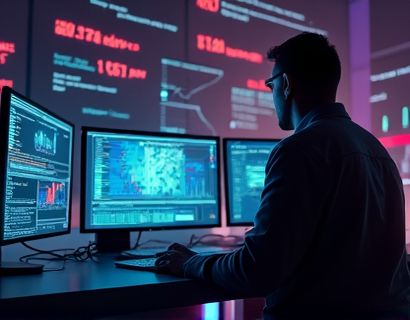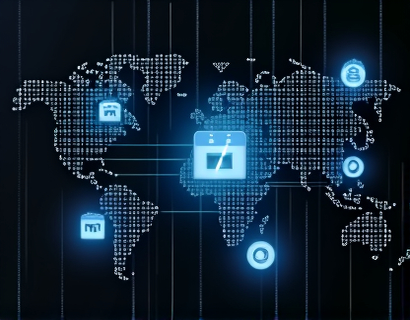Blockchain-Powered Asset Tokenization: Transforming Real-World Assets for Enhanced Market Accessibility and Liquidity
Blockchain technology is at the forefront of a revolutionary shift in asset management, enabling the seamless tokenization of real-world assets. This transformation is significantly enhancing liquidity and market accessibility, offering a new paradigm for individuals and businesses to engage with their assets. By integrating physical assets into the digital ecosystem, blockchain provides a secure, transparent, and efficient framework for asset management.
The concept of asset tokenization involves converting tangible assets such as real estate, art, and infrastructure into digital tokens on a blockchain. These tokens represent fractional ownership or a claim on the asset, allowing multiple parties to invest in and trade these assets more easily. This process not only democratizes access to high-value assets but also introduces a level of transparency and security that traditional asset management cannot match.
Enhancing Liquidity through Tokenization
One of the most significant benefits of blockchain-powered asset tokenization is the enhancement of liquidity. Traditional real-world assets are often illiquid, meaning they cannot be quickly bought or sold without significantly affecting their price. Tokenization changes this dynamic by breaking down assets into smaller, tradable units. This fragmentation allows for more frequent and smaller transactions, making it easier for investors to enter and exit positions without causing substantial price fluctuations.
For instance, a piece of commercial real estate valued at millions of dollars can be tokenized into thousands of smaller shares. Each share can then be bought and sold on a blockchain platform, providing liquidity to investors who might otherwise be deterred by the high entry cost. This increased liquidity attracts a broader range of investors, from individual retail investors to institutional funds, thereby expanding the market for these assets.
Improving Market Accessibility
Accessibility is another critical area where blockchain tokenization makes a substantial impact. Traditionally, investing in real-world assets required significant capital, legal expertise, and often, connections within the industry. Tokenization lowers these barriers by allowing anyone with an internet connection to participate in the market. The process is simplified through user-friendly platforms that handle the complexities of blockchain transactions, making it accessible to a global audience.
Moreover, the reduced entry barriers mean that emerging markets and underserved regions can gain access to investment opportunities that were previously out of reach. This democratization of investment not only fosters economic growth but also promotes financial inclusion, enabling more people to build wealth through asset ownership.
Ensuring Security and Transparency
Security and transparency are foundational to the blockchain ecosystem, and asset tokenization leverages these attributes to create a trustworthy environment for asset management. Blockchain's decentralized and immutable ledger ensures that all transactions are recorded and verified, reducing the risk of fraud and errors. This transparency builds trust among participants, as they can independently verify the authenticity and ownership of assets.
Smart contracts, self-executing contracts with the terms directly written into code, further enhance security by automating and enforcing the rules of asset transactions. These contracts eliminate the need for intermediaries, reducing costs and the potential for human error or manipulation. The use of cryptographic techniques ensures that asset ownership and transaction details are securely stored and accessible only to authorized parties.
Case Studies and Real-World Applications
Several notable projects and platforms are already demonstrating the potential of blockchain-powered asset tokenization. One prominent example is RealT, a platform that tokenizes commercial real estate. RealT allows investors to purchase fractions of properties, providing exposure to high-quality real estate without the need for large upfront investments. This model has attracted a diverse range of investors, from institutional funds to individual investors, thereby increasing market liquidity and accessibility.
Another example is Basis Capital, which focuses on tokenizing art and collectibles. By tokenizing these assets, Basis Capital enables fractional ownership, making high-value art accessible to a broader audience. This not only increases the liquidity of these assets but also provides artists and collectors with new revenue streams and exposure.
Real Estate Tokenization
Real estate tokenization is one of the most advanced and widely adopted forms of asset tokenization. Platforms like RealT and Propy are leading the way by tokenizing commercial and residential properties. These platforms offer several advantages, including fractional ownership, lower transaction costs, and increased liquidity. Investors can buy, sell, and trade property tokens on blockchain exchanges, similar to trading stocks or cryptocurrencies.
For example, RealT's platform allows users to purchase tokens representing a share of a commercial property. These tokens can be traded on secondary markets, providing liquidity to investors. The use of smart contracts ensures that rental income and maintenance responsibilities are automatically managed, reducing the administrative burden on investors.
Art and Collectibles
Tokenizing art and collectibles is another exciting application of blockchain technology. Platforms like Basis Capital and SuperRare are enabling artists and collectors to tokenize unique pieces, creating digital representations of ownership. This not only preserves the provenance and authenticity of the art but also allows for fractional ownership, making it possible for multiple parties to own a piece of a valuable artwork.
These platforms also facilitate secondary market transactions, allowing owners to buy and sell their tokens easily. This increased liquidity is particularly beneficial for artists, who can receive ongoing royalties from secondary sales, ensuring a continuous income stream.
Challenges and Considerations
Despite the numerous benefits, blockchain-powered asset tokenization is not without its challenges. Regulatory uncertainty remains a significant hurdle, as governments worldwide are still grappling with how to classify and regulate tokenized assets. Clear and consistent regulations are essential to ensure the sustainable growth of this market and to protect investors.
Another challenge is the technical complexity involved in tokenizing assets. Ensuring that the tokenization process is seamless and user-friendly is crucial for widespread adoption. Platforms must invest in robust infrastructure and user education to overcome these barriers.
Additionally, market volatility can impact the value of tokenized assets, especially those tied to volatile underlying assets like cryptocurrencies. Investors need to be aware of these risks and manage their portfolios accordingly. However, the long-term potential for stable and growing value in tokenized assets is significant, particularly as the market matures and stabilizes.
Future Prospects
The future of blockchain-powered asset tokenization looks promising, with ongoing advancements in technology and increasing regulatory clarity. As more institutions and industries adopt blockchain solutions, the ecosystem will continue to grow and evolve. The integration of blockchain with other technologies, such as the Internet of Things (IoT) and artificial intelligence (AI), will further enhance the capabilities of asset tokenization.
For instance, IoT can provide real-time data on the condition and usage of physical assets, enabling more informed investment decisions. AI can analyze market trends and predict asset performance, helping investors make better choices. These integrations will not only improve the efficiency and accuracy of asset management but also open up new possibilities for innovation and growth.
In conclusion, blockchain-powered asset tokenization is transforming the way real-world assets are managed, traded, and invested in. By enhancing liquidity, improving accessibility, and ensuring security and transparency, this technology is unlocking new potential for individuals and businesses alike. As the market continues to mature, the benefits of tokenization will become even more pronounced, paving the way for a more inclusive and dynamic asset management landscape.










































